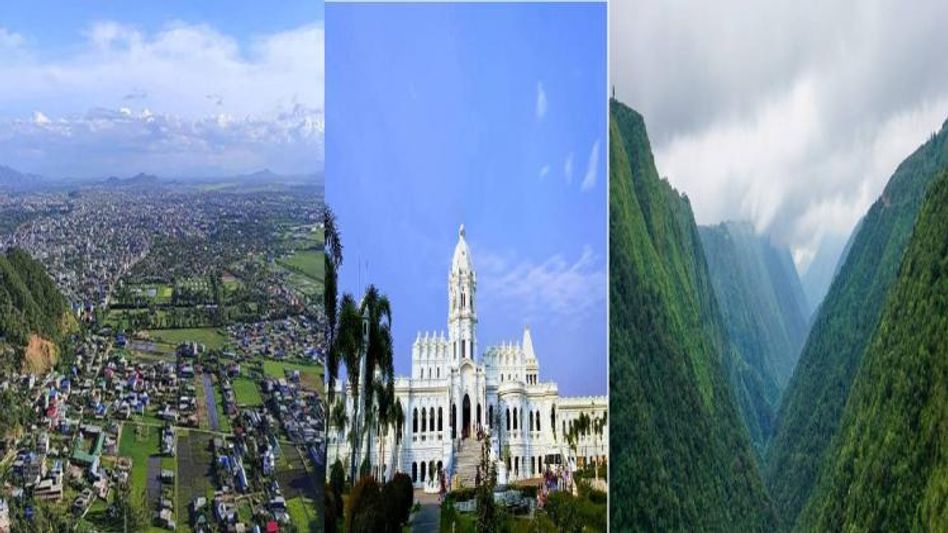Statehood day observed in Tripura, Meghalaya and Manipur
To solve this issue, the Maharaja reached Shillong, however, things didn't go as per plan and he was put under house arrest at his residence in Shillong.
 Tripura, Meghalaya and Manipur statehood day
Tripura, Meghalaya and Manipur statehood dayJanuary 21 might be a usual date for many of us, but for the people of Tripura, Manipur, and Meghalaya, this date takes them 24 years back to when these three were not fully fledged states.
On this day, in 1972, when India had already been freed from the clutches of British rule and had breathed for 24 years, the three states -- Tripura, Manipur, and Meghalaya -- with their own history gained recognition as states under the North Eastern Region (Reorganisation) Act of 1971.
It has been five decades since the northeastern states of Manipur, Meghalaya, and Tripura became separate states.
Prime Minister Narendra Modi, and Assam Chief Minister Himanta Biswa Sarma on January 20 greeted these three northeastern states on their statehood day.
''These states have traversed the growth trajectory in the last few years. I wished that these states continue their growth momentum,'' PM Modi said in a separate tweet for these three northeastern states.
On the other hand, Assam CM also extended his greeting to the people of these three states and prayed for their progress.
''Endowed with spectacular beauty, vibrant culture & rich traditions, our Sister States of Meghalaya, Manipur & Tripura today celebrate their 51st Statehood Day.
My warm greetings to the people & pray for the progress of the neighbouring States,'' he tweeted.
Endowed with spectacular beauty, vibrant culture & rich traditions, our Sister States of Meghalaya, Manipur & Tripura today celebrate their 51st Statehood Day.
— Himanta Biswa Sarma (@himantabiswa) January 21, 2023
My warm greetings to the people & pray for progress of the neighbouring States.
While Manipur and Tripura, which were the princely states then, were absorbed into India in 1949, Meghalaya was part of Assam.
On August 11, 1947, Maharaja Bodhachandra, who ruled Manipur, signed the 'Instrument of Accession' and initiated the process of state accession to the Union of India. However, the official merger of the Manipur did not take place as planned following the arguments of some ethnic groups who argued that terms were given the green flag with the consensus and under duress.
Later in 1949, Major General Rawal Amar Singh was given the position of Dewan of Manipur with powers to interfere in the internal matters of the state which didn't go well with Maharaja. To solve this issue, the Maharaja reached Shillong, however, things didn't go as per plan and he was put under house arrest at his residence in Shillong.
However, without consulting the popularly elected Legislative Assembly of Manipur, the Government of India succeeded in pressuring the Maharaja to sign the Instrument of Accession in September 1949.
The state witnessed a slow transformation to Union Territory in 1956, and ultimately, through the Reorganisation Act, it became a state in 1972.
The princely state of Tripura was ruled by the Maharajas of the Manikya dynasty. Under Maharaja Bir Bikram Kishore's rule, Tripura was absorbed into India in 1949. They went through a series of status changes and finally became a full-fledged state on January 21, 1972.
Coming to Meghalaya, the Khasi, Garo and Jaintia Hills were parts of Assam before the Reorganisation Act was implemented, marking them into Meghalaya's territory. During British rule, the tribal communities in Meghalaya, who had survived on their own, were able to preserve their culture.
In 1947, when India gained independence, the local rulers joined India. Meghalaya was given special protection in order to protect its unique tribal culture and later it slowly became an autonomous state within Assam itself, before becoming an independent state of India in 1972.
Also read: Centre brings new endorsement guidelines for social media influencers
Copyright©2025 Living Media India Limited. For reprint rights: Syndications Today









